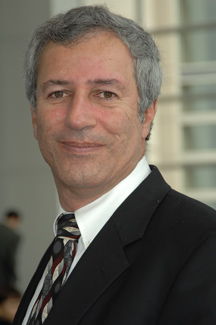November 1, 2013 - Energy Academic Group
A Technical and Operational Perspective on the DOE Energy Innovation Hub in Fuels from Sunlight, the Joint Center for Artificial Photosynthesis
November 1, 2013
ME Auditorium
1300
Professor Nathan. S. Lewis
California Institute of Technology,
Division of Chemistry and Chemical Engineering,
Beckman Institute and Kavli Nanoscience Institute
Abstract
The design of highly efficient, non-biological, molecular-level energy conversion machines that generate fuels directly from sunlight, water, and carbon dioxide is both a formidable challenge and an opportunity that, if realized, could have a revolutionary impact on our energy system. Basic research has already provided enormous advances in our understanding of the subtle and complex photochemistry behind the natural photosynthetic system, and in the use of inorganic photo-catalytic methods to split water or reduce carbon dioxide key steps in photosynthesis. Yet we still lack sufficient knowledge to design solar fuel generation systems with the required efficiency, scalability, and sustainability to be economically viable.
In the DOE Energy Innovation Hub, the Joint Center for Artificial Photosynthesis, we are developing an artificial photosynthetic system that will only utilize sunlight and water as the inputs and will produce hydrogen and oxygen as the outputs. We are taking a modular, parallel development approach in which the three distinct primary components-the photoanode, the photocathode, and the product-separating but ion-conducting membrane-are fabricated and optimized separately before assembly into a complete water-splitting system. The design principles incorporate two separate, photosensitive semiconductor/liquid junctions that will collectively generate the 1.7-1.9 V at open circuit necessary to support both the oxidation of H2O (or OH-) and the reduction of H+ (or H2O). The photoanode and photocathode will consist of rod-like semiconductor components, with attached heterogeneous multi-electron transfer catalysts, which are needed to drive the oxidation or reduction reactions at low overpotentials. This talk will discuss a feasible and functional prototype and blueprint for an artificial photosynthetic system, composed of only inexpensive, earth-abundant materials, that is simultaneously efficient, durable, scalably manufacturable, and readily upgradeable, including both the operational and technical scope of the JCAP Hub, as well as technical results towards this goal that has recently been developed at Caltech.
Biography
Dr. Nathan Lewis, the George L. Argyros Professor of Chemistry, has been on the faculty at the California Institute of Technology since 1988 and has served as Professor since 1991. He is the Scientific Director of the Joint Center for Artificial Photosynthesis, the Energy Innovation Hub in Fuels from Sunlight, and has also served as the Principal Investigator of the Beckman Institute Molecular Materials Resource Center at Caltech since 1992. From 1981 to 1986, he was on the faculty at Stanford, as an assistant professor from 1981 to 1985 and as a tenured Associate Professor from 1986 to 1988. Dr. Lewis received his Ph.D. in Chemistry from the Massachusetts Institute of Technology.
Dr. Lewis has been an Alfred P. Sloan Fellow, a Camille and Henry Dreyfus Teacher-Scholar, and a Presidential Young Investigator. He received the Fresenius Award in 1990, the ACS Award in Pure Chemistry in 1991, the Orton Memorial Lecture award in 2003, the Princeton Environmental Award in 2003 and the Michael Faraday Medal of the Royal Society of Electrochemistry in 2008. He is currently the Editor-in-Chief of the Royal Society of Chemistry journal, Energy & Environmental Science. He has published over 300 papers and has supervised over 60 graduate students and postdoctoral associates.
His research interests include artificial photosynthesis and electronic noses. Technical details of these research topics focus on light-induced electron transfer reactions, both at surfaces and in transition metal complexes, surface chemistry and photochemistry of semiconductor/liquid interfaces, novel uses of conducting organic polymers and polymer/conductor composites, and development of sensor arrays that use pattern recognition algorithms to identify odorants, mimicking the mammalian olfaction process.
POC
Dr. Daniel A. Nussbaum
Naval Postgraduate School
Principal, Energy Academic Group
Monterey CA 93943
Phone: 831-656-2387
Mobile: 831-324-3228
Email: dnussbaum@nps.edu


